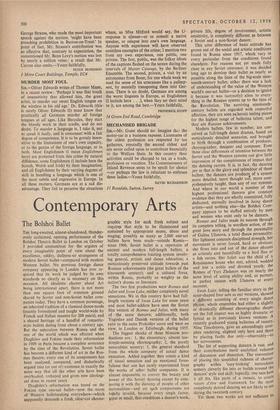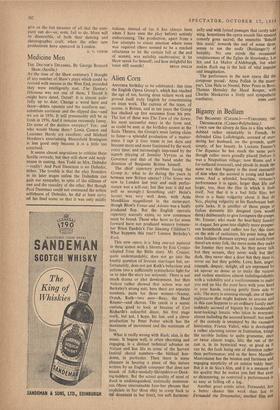Contemporary Arts
The Bolshoi Ballet THE long-awaited, almost-abandoned, thunder- ously acclaimed, opening performance of the Bolshoi Theatre Ballet in London on October 3 provided ammunition for the arguers of every imaginable point of view about the excellence, oddity, dullness or strangeness of modern Soviet ballet—compared with modern Western ballet. No previous foreign dance company appearing in London has ever re- quired that its work be judged by its own standards so clearly as is necessary on this occasion. All idealistic chatter about Art being international apart, there is not more than one square foot of common ground shared by Soviet and non-Soviet ballet com- panies today. They have a common parentage, an inherited tradition of a classical dance-mode (mainly formulated and taught world-wide by French and Italian masters for 200 years), and a shared heritage of a handful of romantic- style ballets dating from about a century ago. But the separation between Russia and the rest of the world which was effected when Diaghilev and Fokine made their reformation in 1909 in Paris became a complete severance by the time of the Revolution. Soviet ballet has become a different kind of art in the Rus- sian theatre; every one of its components has been analysed, compared, and dialectically argued into (or out of) existence in exactly the same way that all the other arts have been overhauled, reshaped and given new ideologi- cal dress in recent years.
Diaghilev's reformation was based on the Fokine type one-act ballet—now the norm of Western balletmaking everywhere—which supposedly demands a fresh, clear-cut choreo-
graphic style for each fresh subject and requires that style to be illuminated and sustained by appropriate music, decor and staging; possibly as many as 2,000 one-act ballets have been made—outside Russia— since 1906. Soviet ballet is a repertoire of ancient and modern full-length ballets; a totally comprehensive training system involv- ing general, artistic and dance education; a meticulously preserved attitude towards past Russian achievements (the great ballets of the nineteenth century); and a cultural force, within Russia, probably as weighty as the nation's drama or literature.
The two first productions were Romeo and Juliet and Swan Lake, neither completely novel sensations. We in this country have had full- length versions of Swan Lake for some years and most ballet-addicts have seen the Soviet film version of Romeo and Juliet, with many of the same dancers; additionally, both Yugoslav and Danish versions of the ballet exist to the same Prokofiev score and were on view, in London or Edinburgh, during 1955.
The biggest shocks of these Moscow pro- ductions are: 1, the elementary, almost too- simple-seeming choreography; 2, the purely naturalistic scenery; 3, the general standard from the whole company of actual dance execution. Added together they create a kind of visual sensation and an emotional force- fulness that one has rarely experienced from the works of other ballet companies. It is almost impossible to convey the beauty and power of this Soviet dancing except by com- paring it with the dancing of people of other nationalities—and yet such comparisons are totally invalid, because every single factor, great or small, that conditions a dancer's work, private life, degree of involvement, artistic sensitivity, is completely different as between a Soviet and a non-Soviet dancer.
This utter difference of basic attitude has grown out of the social and artistic conditions found in Russia since 1917, which vary in every particular from the conditions found elsewhere. For reasons not yet made fully clear in any Soviet utterance, it was decided long ago to develop their ballet as nearly as possible along the lines of the big-scale nine- teenth-century ballet; either there was a lack of understanding of the value of the Western world's one-act ballet—or a decision to ignore it because it was (correctly) alien to every- thing in the Russian system up to the time of the Revolution. The surviving nineteenth- century ballets are regarded with respectful affection, they are seen as. heroic testing pieces for the highest range of ballerina talent, and they are Russian achievements.
Modern ballets, few in number, are con- ceived as full-length dance dramas, based on meticulously detailed scenarios, and brought to birth through a combination of producer, choreographer, designer and composer. Even these clear differences of intention between the Soviet and the Western systems can give little impression of the completeness of impact that the dancing carries. It is, in fact, the dancing per se that is the glory and splendour of these ballets; the dancers are products of a system more detailed, more thought out, more com- prehensively taught, than any of our systems. And where in our world a number of the highest professional dancers give constant evidence that they are wholly committed, fully dedicated, eternally involved in being dance artists—and nothing else—the Bolshoi Com- pany appears to be staffed entirely by men and women who exist only to be dancers. Romeo and Juliet made its success through its complete telling, in wordless action, of the great love story and through the personality of Galina Ulanova, a total dance personality. Her lightness conceals disciplined strength, her movement is never forced, hard or obvious; she flows into and out of the dance phrases as artlessly and beautifully as a bird flies or a fish swims. Her Juliet was the child of a Renaissance house who met, adored, wedded and lost a noble and devoted youth; the Romeo of Yuri Zhdanov was on nearly the same level of acting ability and, as partner, in perfect unison with Ulanova at every moment.
Swan Lake, telling the familiar story in the same-shaped four acts as our versions, showed a different accenting of every single dance phrase; whole ensembles had either a slightly or drastically different choreographic shape; yet the full impact was as highly dramatic or lyrical as in previously known versions. A recently graduated young ballerina of twenty. Nina Timofeyeva, gave an astoundingly com- plete rendering, slighted only here and there by placing faults due only—observably—to her nervousness. The list of supporting dancers is vast, and their contributions merit analytical volumes of discussion and dissection. The convention of placing this simplified richness of choreo- graphy within 'easy-looking' naturalistic scenery cleverly fits into or builds around the dancers' style and skill; logically, one sees hoW it all fits, like parts of a mosaic, to create raison d'etre and framework for the most completely danced dancing we are likely to see during the twentieth century.
Yet these two works are not sufficient to give us the full measure of all that the com- pany can do—or, even, fail to do. More will be discernible, of both their dancing and choreographic craft, when the other new productions have appeared in London.
A. V. COTON











































 Previous page
Previous page